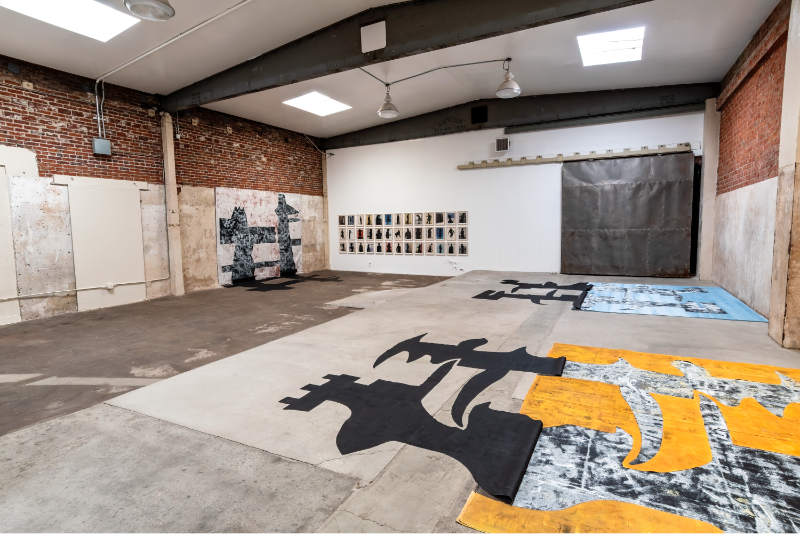Not front of house, with its symmetrically billeted art objects reflecting in its polished concrete floor, these rawboned works by HK Zamani are arrayed deep in the back, in a brick and concrete garage, its loading dock and ramp illumined by dangling warehouse floodlights. And it is exactly where they belong, because pretty they ain’t.
While there are only four works presented, Inadvertent Protagonists I, II, & III, and Fashion Erasures (all 2021) the exhibition is an enveloping and disconcerting experience. All are large; the slightest dimension of Inadvertent Protagonists is an 8-feet width, while Fashion Erasures, a series of 39 smaller works little more than 45-inches high, is 11-feet wide. The latter is a series of framed figures, magazine layouts with the imprimatur of high-end couture; yet these figures of fashionista idolatry, once envied and beatified, are transformed in Zamani’s cameos. These icons of desire and emulation have been distorted, becoming abominations of their former selves, misshapen silhouettes of the beastliness within that we so desperately fear confessing. The beautiful models have been transformed into horned and blackened cutouts, tentacled creatures with fins for ears, razors as elbows, pickaxes for tongues. Arranged as they are, like a series of film stills, they suggest a disturbing Muybridge or broken zoetrope, and in this metamorphosis names like Galliano, Valentino and Gucci become Manticore, Basilisk and Chimera. The artist suggests that we see ourselves, our true and unglamorized selves, as part of this shameful vanity, and realize our presumedly well-deserved desires as little more than a humbug.

HK Zamani, “Inadvertent Protagonists,” installation view, 2021. Photo By Carl Berg. Courtesy PRJCTLA.
The Inadvertent Protagonists, three larger works on unmounted canvas, are even more fearsome yet. Scraped and weathered, these paintings—a moniker they might dispute—release their shadows to crawl along the crackled floor toward the viewer as if eagerly bearing a message. Each one is a deformed triptych, a sandwiched cut-out of a painting in shallow relief. Two layers of canvas are devised into three, each contrastingly painted. The top layer has been scissored and folded over to reveal blackened profiles, far more ominous than those seen in Fashion Erasures, and these “shadows” appear eager to envelop the spectator. Protagonists II and III lie on the floor and give the impression of the long remnants oozing inexorably forward, while Protagonists I is wall-mounted and its figures appear to have fallen forward with an almost audible slap, exhausted and resting in anticipation of the bell that signals the next round. In each work the painted surface is raw and scraped, their colors faded and mottled, and each creature/figure/memory/shadow seems locked in irrevocable conflict with its partner/opponent/reflection/distortion.
The theatricality of the installation makes for a stunning experience as the artwork and its setting could not have been more suitably paired; grim and bleak have combined to summon a visual and sensory experience rarely found in the anodyne and moneyed ambience of the art gallery. The cement floor echo and the aged crumbling brick have assembled a chorus for painting stripped bare.



















The best art I saw this year.
Very happy for my friend.
Best art I’ve seen this year.
Big fan of mr. Zamani work.